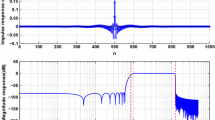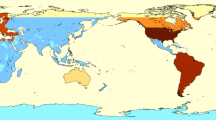Abstract
A gravity field model is computed from the four accurate gravitational gradient components of GOCE (Gravity field and steady-state Ocean Circulation Explorer), combined with the analysis of the kinematic orbits, and some moderate constraint (or stabilization) in the polar areas where no observation from GOCE is available due to the orbit geometry. The normal matrix of each component is computed individually in order to study its contribution to the combined solution. The results show that the contribution of Vzz is the largest, with an average value of 32.74% of the total solution; the second and the third largest are Vzz and Vyy, with average values of 28.04% and 26.08%, respectively; the component Vxz contributes 11.81%. Validation with external data shows that each component has its characteristic value and that the information content of the component Vxz is not negligible and should be included for gravity field recovery. The orbit part as derived from high-low satellite-to-satellite tracking (SST-hl) to the GPS contributes mostly to the coefficients below degree and order (d/o) 20, and to non-zonal coefficients from d/o 20 to 80. The mean value of the contribution of the polar stabilization is the smallest with a value of 0.22%, nevertheless it is important. In addition to the contribution analysis in terms of the normal matrices, each individual component of the gradiometer has been combined with SST and polar stabilization, to give a set of single component gravity field models. These partially combined solutions are compared to the fully combined solution in terms of geoid differences. They show that the partially combined solution with Vzz is closest to the complete solution. Even closer is a combination with Vxx and Vyy. In addition to the GOCE-only solution, a GOCE-GRACE (Gravity Recovery And Climate Experiment) combined gravity field model is derived and the information content of GOCE and an available set of normal equations of GRACE are investigated. Results show that, as expected, GRACE dominates the solution below degree 90 and GOCE above degree 140.
Similar content being viewed by others
References
Baur O., 2007. Die Invariantendarstellung in der Satellitengradiometrie: theoretische Betrachtungen und numerische Realisierung anhand der Fallstudie GOCE. PhD Thesis, University of Stuttgart, Stuttgart, Germany (in German).
Baur O., Sneeuw N. and Grafarend E.W., 2007. Methodology and use of tensor invariants for satellite gravity gradiometry. J. Geodesy, 82, 279–293, DOI: 10.1007/s00190-007-0178-5.
Biancale R., Balmino G., Lemoine J., Marty J., Moynot B., Barlier F., Exertier P., Laurain O., Gegout P., Schwintzer P., Reigber C., Bode A., König R., Massmann F., Raimondo J., Schmidt R. and Zhu S.Y., 2000. A new global earth’s gravity field model from satellite orbit perturbations: GRIM5-S1. Geophys. Res. Lett., 27, 3611–3614, DOI: 200010.1029 /2000GL011721.
Bock H., Jäggi A., Meyer U., Visser P., van den IJssel J., van Helleputte T., Heinze M. and Hugentobler U., 2011. GPS-derived orbits for the GOCE satellite. J. Geodesy, 85, 807–818, DOI: 10.1007/s00190-011-0484-9.
Brockmann J. and Schuh W.D., 2010. Fast variance component estimation in GOCE data processing. In: Mertikas S.P. (Ed.), Gravity, Geoid and Earth Observation. International Association of Geodesy Symposia, 135, Springer-Verlag, Heidelberg, Germany, 185–193.
Dong D., Herring T.A. and King R.W., 1998. Estimating regional deformation from a combination of space and terrestrial geodetic data. J. Geodesy, 72, 200–214, DOI: 10.1007 /s001900050161.
European Space Agency, 1999. Gravity Field and Steady-State Ocean Circulation Mission — The Four Candidate Earth Explorer Core Missions. Technical Report, ESA SP-1233(1), European Space Agency Publications Division, Noordwijk, The Netherlands.
Flechtner F., 2007. AOD1B Product Description Document for Product Releases 01 to 04. Technical Report GR-GFZ-AOD-0001, GeoForschungszentrum Potsdam, Potsdam, Germany (http://op.gfz-potsdam.de/grace/results/grav/AOD1B_PDD_20070413.pdf).
Floberghagen R., Fehringer M., Lamarre D., Muzi D., Frommknecht B., Steiger C., Piñeiro J. and Costa A., 2011. Mission design, operation and exploitation of the gravity field and steadystate ocean circulation explorer mission. J. Geodesy, 85, 749–758, DOI: 10.1007/s00190-011-0498-3.
Frommknecht B., Lamarre D., Meloni M., Bigazzi A. and Floberghagen R., 2011. GOCE level 1b data processing. J. Geodesy, 85, 759–775, DOI: 10.1007/s00190-011-0497-4.
Goiginger H., Rieser D., Mayer-Guerr T., Pail R., Schuh W.-D., Jäggi A., Maier A. and the GOCO Consortium Team, 2011. The combined satellite-only global gravity field model GOCO02S. Geophys. Res. Abs., 13, EGU2011–10571 (http://meetingorganizer.copernicus.org/EGU2011/EGU2011-10571.pdf).
Gruber T. and Rummel R., 2006. Concept and capability of GOCE. In: Knudsen P., Johannessen J., Gruber T., Stammer S. and van Dam T. (Eds.), Proceedings of the Workshop:GOCINA, Improving Modelling of Ocean Transport and Climate Prediction in the North Atlantic Region Using GOCE Gravimetry. Cahiers du Centre Européen de Géodynamique et de Séismologie, 25, European Center for Geodynamics and Seismology (ECGS), 31–37.
Gruber T., Rummel R., Abrikosov O. and van Hees R. (Eds.), 2012. GOCE Level 2 Product Data Handbook. GO-MA-HPF-GS-0110, Issue 4, Revision 3. European Space Agency, Noordwijk, The Netherlands.
Gruber T., Visser P.N.A.M., Ackermann C. and Hosse M., 2011. Validation of GOCE gravity field models by means of orbit residuals and geoid comparisons. J. Geodesy, 85, 845–860, DOI: 10.1007/s00190-011-0486-7.
Hofmann-Wellenhof B. and Moritz H., 2006. Physical Geodesy. Springer-Verlag, Berlin, Germany.
Jackson D.D., 1972. Interpretation of inaccurate, insufficient and inconsistent data. Geophys. J. R. Astron. Soc., 28, 97–109, DOI: 10.1111/j.1365-246X.1972.tb06115.x.
Jackson D.D., 1979. The use of a priori data to resolve non-uniqueness in linear inversion. Geophys. J. Int., 57, 137–157, DOI: 10.1111/j.1365-246X.1979.tb03777.x.
Johannessen J.A., Balmino G., Provost C.L., Rummel R., Sabadini R., Sünkel H., Tscherning C., Visser P., Woodworth P., Hughes C., Legrand P., Sneeuw N., Perosanz F., Aguirre-Martinez M., Rebhan H. and Drinkwater M., 2003. The European gravity field and steadystate ocean circulation explorer satellite mission: Its impact on geophysics. Surv. Geophys., 24, 339–386, DOI: 10.1023/B:GEOP.0000004264.04667.5e.
Klees R., Ditmar P. and Broersen P., 2003. How to handle colored observation noise in large leastsquares problems. J. Geodesy, 76, 629–640, DOI: 10.1007/s00190-002-0291-4.
Koch K. and Kusche J., 2002. Regularization of geopotential determination from satellite data by variance components. J. Geodesy, 76, 259–268, DOI: 10.1007/s00190-002-0245-x.
Kusche J., 2003. A Monte-Carlo technique for weight estimation in satellite geodesy. J. Geodesy, 76, 641–652, DOI: 10.1007/s00190-002-0302-5.
Lerch F.J., 1991. Optimum data weighting and error calibration for estimation of gravitational parameters. Bull. Géod., 65, 44–52, DOI: 10.1007/BF00806341.
Lerch F.J., Klosko S.M. and Patel G.B., 1982. A refined gravity model from lageos (GEM-L2). Geophys. Res. Lett., 9, 1263–1266, DOI: 198210.1029/GL009i011p01263.
Mayer-Gürr T., 2006. Gravitationsfeldbestimmung aus der Analyse kurzer Bahnbögen am Beispiel der Satellitenmissionen CHAMP und GRACE. PhD Thesis, University of Bonn, Bonn, Germany (in German).
Mayer-Gürr T., Eicker A., Kurtenbach E. and Ilk K.H., 2010. ITG-GRACE: global static and temporal gravity field models from GRACE data. In: Flechtner F.M., Gruber T., Güntner A., Mandea M., Rothacher M., Schöne T. and Wickert J. (Eds.), System Earth via Geodetic-Geophysical Space Techniques. Advanced Technologies in Earth Sciences, Springer-Verlag, Berlin, Germany, 159–168, DOI: 10.1007/978-3-642-10228-8 13.
Mayrhofer R., Pail R. and Fecher T., 2010. Quick-look gravity field solutions as part of the GOCE quality assessment. In: Lacoste-Francis H. (Ed.), Proceedings of ESA Living Planet Symposium. ESA SP-686, European Space Agency, Noordwijk, The Netherlands, ISBN 978-92-9221-250-6 (https://online.tugraz.at/tug_online/voe_main2.getvolltext?pCurrPk=55603).
McCarthy D. and Petit G. (Eds.), 2004. IERS Conventions (2003). IERS Technical Note 32, Verlag des Bundesamts für Kartographie und Geodäsie, Frankfurt am Main, Germany, 127 pp., ISBN: 3-89888-884-3.
Metzler B. and Pail R., 2005. GOCE data processing: The spherical cap regularization approach. Stud. Geophys. Geod., 49, 441–462, DOI: 10.1007/s11200-005-0021-5.
Migliaccio F., Reguzzoni M. and Sansò F., 2004. Space-wise approach to satellite gravity field determination in the presence of coloured noise. J. Geodesy, 78, 304–313, DOI: 10.1007 /s00190-004-0396-z.
Montenbruck O. and Gill E., 2000. Satellite Orbits: Models, Methods and Applications, 1st Edition. Springer-Verlag, Berlin, Germany.
Pail R., Goiginger H., Schuh W.-D., Höck E., Brockmann J.M., Fecher T., Gruber T., Mayer-Gürr T., Kusche J., Jäggi A. and Rieser D., 2010. Combined satellite gravity field model GOCO01S derived from GOCE and GRACE. Geophys. Res. Lett., 37, L20314, DOI: 10.1029 /2010GL044906.
Pail R., Bruinsma S., Migliaccio F., Förste C., Goiginger H., Schuh W.-D, Höck E., Reguzzoni M., Brockmann J.M., Abrikosov O., Veicherts M., Fecher T., Mayrhofer R., Krasbutter I., Sansó F. and Tscherning, C.C., 2011. First GOCE gravity field models derived by three different approaches. J. Geodesy, 85, 819–843, DOI: 10.1007/s00190-011-0467-x.
Pavlis N.K., Holmes S.A., Kenyon S.C. and Factor J.K., 2012. The development and evaluation of the Earth Gravitational Model 2008 (EGM2008). J. Geophys. Res., 117, B04406, DOI: 10.1029/2011JB008916.
Reigber C., Schmidt R., Flechtner F., König R., Meyer U., Neumayer K., Schwintzer P. and Zhu S.Y., 2005. An earth gravity field model complete to degree and order 150 from GRACE: EIGEN-GRACE02S. J. Geodyn., 39, 1–10, DOI: 10.1016/j.jog.2004.07.001.
Rummel R., 1986. Satellite gradiometry. In: Sünkel H. (Ed.), Mathematical and Numerical Techniques in Physical Geodesy. Lecture Notes in Earth Sciences, 7, Springer-Verlag, Berlin, Germany, 317–363, DOI: 10.1007/BFb0010135.
Rummel R., Yi W. and Stummer C., 2011. GOCE gravitational gradiometry. J. Geodesy, 85, 777–790, DOI: 10.1007/s00190-011-0500-0.
Savcenko R. and Bosch W., 2008. EOT08a — Empirical Ocean Tide Model from Multi-Mission Satellite Altimetry. DGFI Report 81, Deutsches Geodätisches Forschungsinstitut (DGFI), Munich, Germany.
Schneider M., 1968. Zur dynamischen Nutzung der Bahnen künstlicher Satelliten. Bundesministerium für wissenschaftliche Forschung (BMwF), Weltraumforschung, Forschungsbericht FB W 68-55, Deutsche Gesellschaft für Flugwissenschaften (DFG), Mitteilungen aus dem Institut für Astronomische und Physikalische Geodäsie, Nr. 53 (in German).
Sneeuw N., 2000. A semi-analytical approach to gravity field analysis from satellite observations. DGK, Reihe C 527, Verlag der Bayerischen Akademie der Wissenschaften, ISBN (Print) 3- 7696-9566-6, ISSN 0065-5325.
Tapley B.D., Bettadpur S., Watkins M. and Reigber C., 2004. The gravity recovery and climate experiment: Mission overview and early results. Geophys. Res. Lett., 31, L09607, DOI: 10.1029/2004GL019920.
van Gelderen M. and Koop R., 1997. The use of degree variances in satellite gradiometry. J. Geodesy, 71, 337–343, DOI: 10.1007/s001900050101.
Visser P., van den IJssel J., van Helleputte T., Bock H., Jäggi A., Meyer U., Beutler G., Heinze M. and Hugentobler U., 2010. Rapid and precise orbit determination for the GOCE satellite. In: Lacoste-Francis H. (Ed.), Proceedings of ESA Living Planet Symposium. ESA SP-686, European Space Agency, Noordwijk, The Netherlands, ISBN 978-92-9221-250-6 (www.fesg.bv.tum.de/mediadb/910338/910339/Visser10.pdf).
Xu P., Shen Y., Fukuda Y. and Liu Y., 2006. Variance component estimation in linear inverse illposed models. J. Geodesy, 80, 69–81, DOI: 10.1007/s00190-006-0032-1.
Yi W., 2012a. An alternative computation of a gravity field model from GOCE. Adv. Space Res., 50, 371–384, DOI: 10.1016/j.asr.2012.04.018.
Yi W., 2012b. The Earth’s Gravity Field from GOCE. CGE Report, Nr. 2, Centre of Geodetic Earth System Research, ISBN (Print) 978-3-934205-34-5, ISSN 2195-7126 (http://www.iapg.bv.tum.de/mediadb/5164634/5164635/CGE_Reports_2.pdf).
Yu J. and Zhao D., 2010. The gravitational gradient tensor’s invariants and the related boundary conditions. Sci. China-Earth Sci., 53, 781–790, DOI: 10.1007/s11430-010-0014-2.
Author information
Authors and Affiliations
Corresponding author
Rights and permissions
About this article
Cite this article
Yi, W., Rummel, R. & Gruber, T. Gravity field contribution analysis of GOCE gravitational gradient components. Stud Geophys Geod 57, 174–202 (2013). https://doi.org/10.1007/s11200-011-1178-8
Received:
Revised:
Accepted:
Published:
Issue Date:
DOI: https://doi.org/10.1007/s11200-011-1178-8




